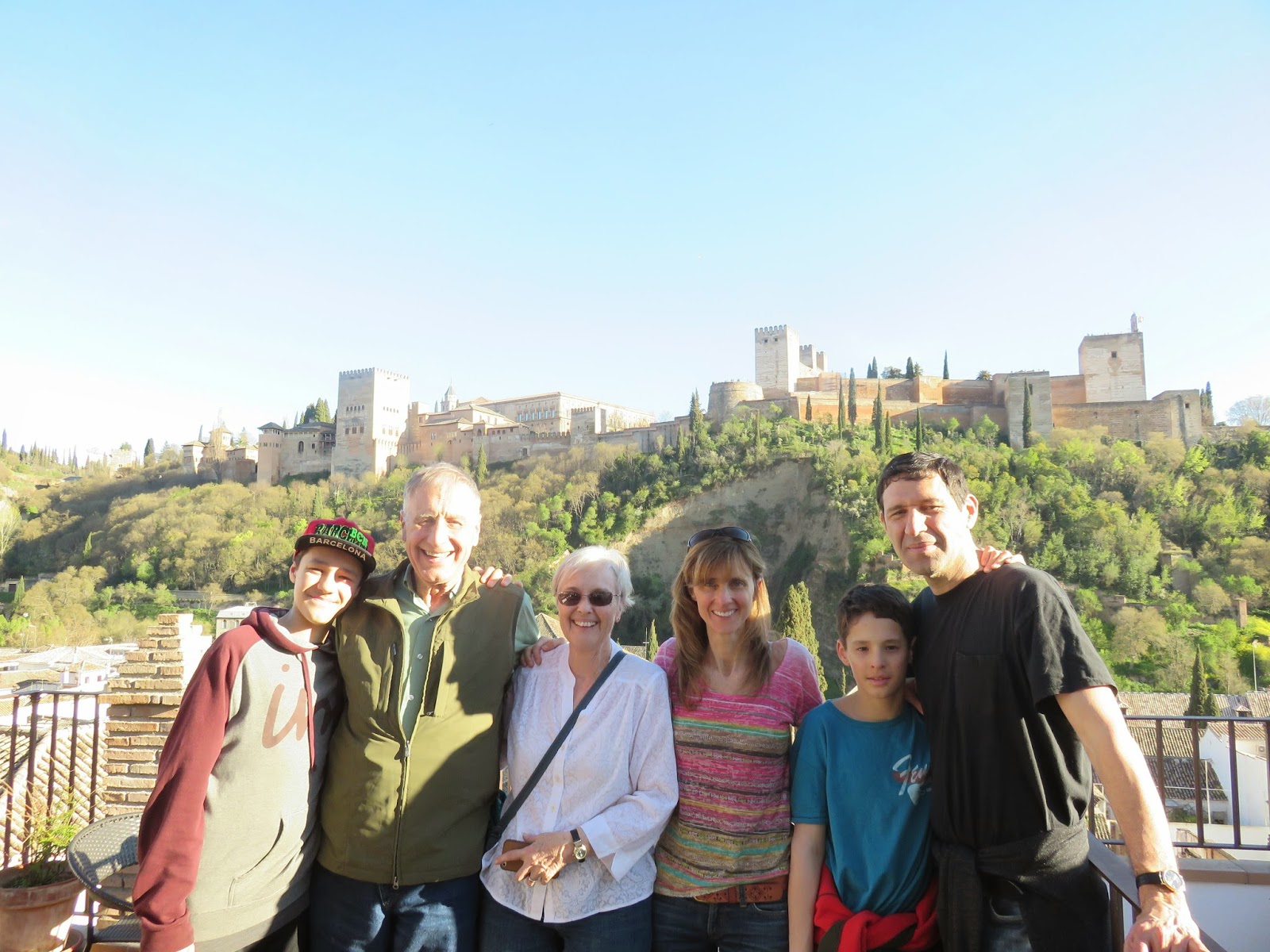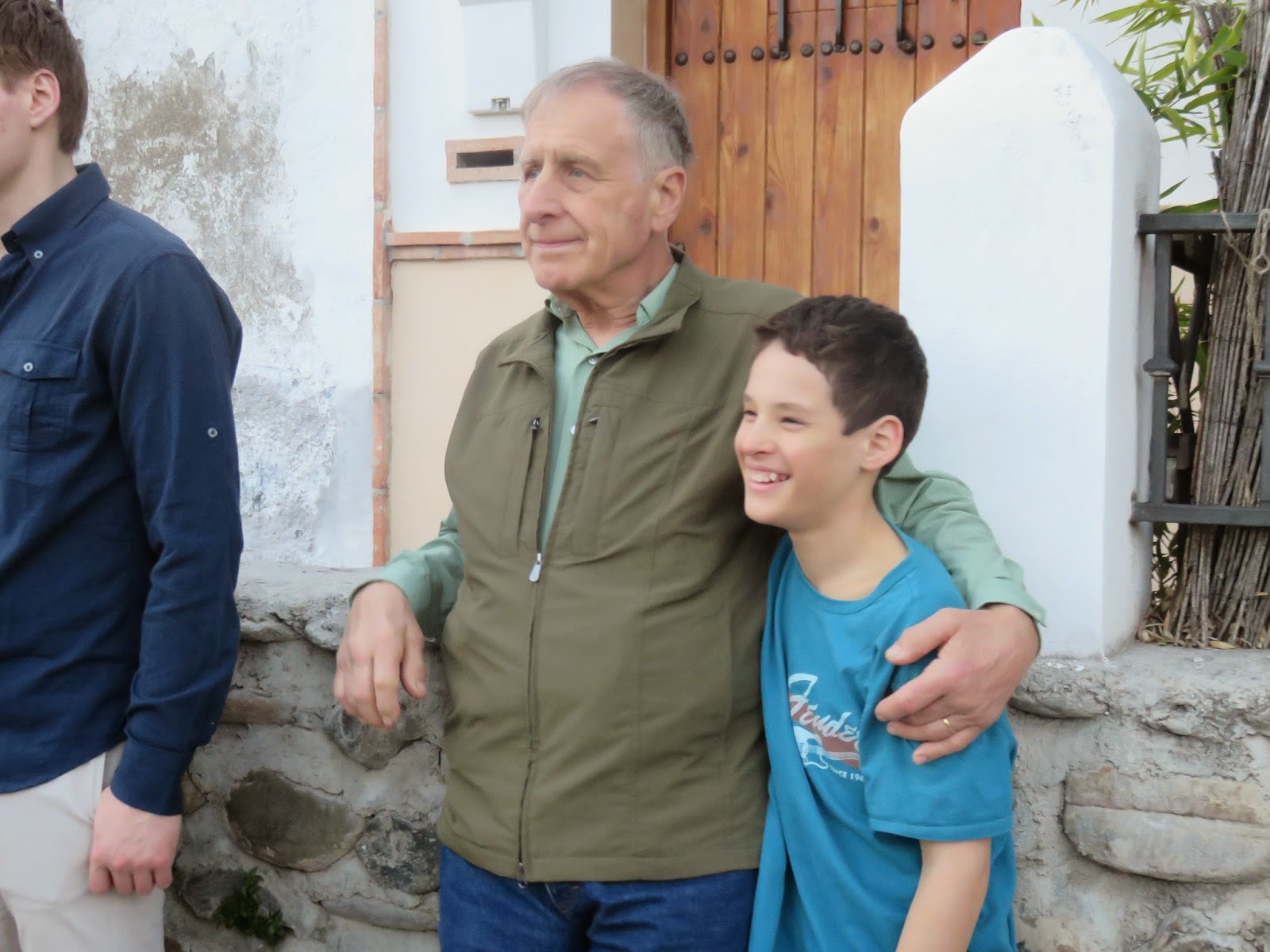We took a trip with Mom and Dad to Andalusia, or southern Spain, and Morocco.
Our first stop was Granada.
Southern Spain has a rich history of Moors (Muslims in Spain), Jews, and Christians. For a long time, these three groups all lived together in harmony, mostly when the Moors were ruling, as the Moors believed they were all "people of the book [Bible]" and should live peaceably. During these peace filled times, people in those societies were happy and productive and had better livelihood overall, and there was freedom to make many advances in art and science. It was mainly the Christians who created havoc and horror in many cases, causing the benefits of a generally free society to flee.
We arrive in Granada!
We took a walk through the Jewish Quarter (now inhabited by people of any faith).
Ray and Jacob are playing with an orange...there were orange trees all around the city. Most of them were in bloom, and constant fragrance wafted through the air during our whole time in Andalusia.
Some fun buildings on our Jewish Quarter walk.
We took a couple walking tours in Granada. Our trip started at the Plaza Isabel la Católica (Isabel the Catholic Plaza). Granada is the place where Isabel and Ferdinand ended the war against the Moors, driving them out of Spain for good. The seized Granada in Janaury of 1492 after a long siege, when the Moorish sultan, Boabdil, surrendered peacefully. The promises Isabel and Ferdinand made in the treaty were only kept for seven years.
Right after Granada was taken, Isabel had a change of heart on backing Columbus on his adventure to find a new trade route. After having spent practically all of her money fighting and kicking out Moors in Spain, she had hardly anything left. It was a Jew (can't remember his name now) who gave the monarchs the money to send Christopher Columbus to the new world. That's something you don't hear about, but we learned it from our tour guide.
Isabel and Columbus statue in Plaza Isabel la Católica
In the Plaza waiting for the tour to begin...
We were in Spain during Semana Santa (Holy Week) leading up to Easter Sunday. This is the biggest celebration week of the year in Andalusia. There are processions down the streets from afternoon until early morning hours every single day. People line up and crowd around to watch the processions, for which each day has a different significance. People in Andalusia take this whole week very seriously, coming together to express religious devotion and to repent. We have been told that every year there are at least a couple days with rain when they don't hold the processions; when this happens, you can find people crying with emotion over this "loss". This year, however, was the first time in many years that there was no rain for the whole week!
On our tour, we went into a church that had some of the pieces that were going to be used for the processions. The floats are carried by people standing under these massive and heavy floats, and often barefoot. They walk very slowly and stand very close together underneath. The carriers do this as an act of repentance and sacrifice.
Walking through Granada along the river on our tour.
Any time there are ruins discovered, it is required that they are viewable to the public. If you find some in your home, you must open your home to the public for a certain number of days per year. Many people choose Christmas Day or some other key days that they know people are busy and won't be touring around looking at ruins. So, when a hotel found ruins, they had to display and open it up to the public. We went in to see it on our tour.
Nicholas chillin' at the rooftop of the hotel
And what a great view from up there! You can see The Alhambra on the hilltop.
The tour guide took a family photo for us.
More photos as we toured Granada...we gradually walked up, up, up.
Yes, Granada has mountains nearby...the Sierra Nevada mountains!
The next two photos are the patio of a Muslim temple, which had been recently built. Apparently, per our tour guide, it was a long fought battle to get the temple built (boils down to prejudice).
Nicholas also took a great number of photos with Dad's (Papa's) iPhone.
The curved arches below are Moorish design and are found throughout Andalusia
Wow, look at those colorful tapas! We only passed by and didn't get to eat.
Papa and Nicholas
Toward the end of our tour we reached Sacromonte, the area where the gypsies (Roma) live. They were forced to live here because it is on the hilly outskirts of the city where no one else wanted to be. The gypsies made the best of it and built their homes into the hills, essentially living in caves, which are still their homes today.
Now that we reached the "top", time to go back down...it was a beautiful walk at dusk.
Again, The Alhambra.
The next day we took another tour, this time in the heart of Granada.
The church below cannot be fully viewed because of the buildings on either side, which were erected so close to the cathedral.
In several of the next photos, you will see "graffiti" on the church building. Actually, when people of status finished a high degree of education, they would "announce" it and put their permanent "plaque" on the walls of the cathedrals, giving the church a sum of money to reciprocate the favor. The words were always written in bull's blood.
This is the Palacio de la Madraza, the first Islamic university which became one of the most important and attracted philosophers from many countries. In the 18th century, a Baroque palace was built in its place, but the architects preserved parts of it.
After all that walking, time for hammam...centuries old Arab baths! We were not allowed to take cameras inside the baths, but these are a couple photos of the lobby. This experience was fabulous! It was like an underground area, of pools that were hot, warm, and cold. There was also a sauna, and you can have massages, too. We spent a wonderful and relaxing time in these gorgeous baths, with mosaics, arches, stone, etc. They have been refurbished, but hold the charm and serenity and elegance of their origins. Even the boys were permitted at their age to use these baths.
One of the processions began with a military and a band.
These characters of the parade (below), called nazarenos (derived from Nazarene), are getting ready for a procession. Yes, these costumes do look like the KKK, but they do not have the same meaning, of course. During the Inquisition in Spain in the Middle Ages, people convicted of not converting to Christianity, or of criminal offenses, were forced to wear this style of hat. It has come to signify penitence, and the face is covered to preserve the identity of those repenting.
In the evening we went to a Flamenco show. WOW! The passion and excellence of each performer was outstanding. The best shows are small, intimate, with usually a couple dancers, a singer, and a guitarist. Each performer plays a significant role, and visually give complete support to one another on stage. It is truly an experience to see a good Flamenco show!
We encountered many processions during our time in Andalusia. I am not putting the photos altogether in the blog so you can see how we met with one after another throughout the days. Once we saw a few, that was enough for us, and we just tried to move around or through them when possible. Below, you can see that they hold candles while walking down the streets. When children turn two years old, their mothers begin a wax ball for them, so you would see kids of all ages running up to the people in the parade wanting some wax from the candles for their balls. Our Spanish teacher, Carmen, grew up in Huelva in Andalusia, and she says she has a giant wax ball from all the years of collecting wax. :)
Here is one of the "floats" being carried through the streets. I believe that's a figure of Virgin Mary.
The processions continue far into the night, but we went to our apartment and went to bed...very early by Spanish standards.





















































No comments:
Post a Comment